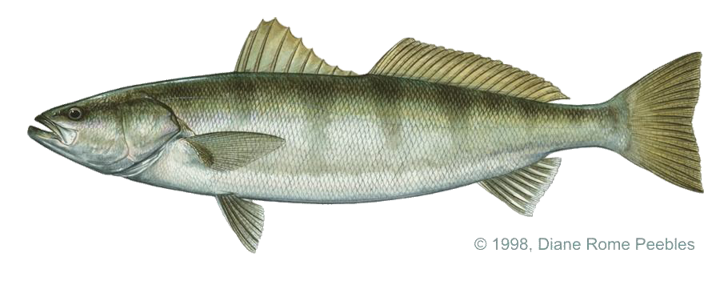Game Fish Identification Reference Guides
Seabass, white
(Atractoscion nobilis)
(Atractoscion nobilis)

(Ayres, 1860); SCIAENIDAE FAMILY; also called Catalina salmon, seatrout, croaker
Inhabits the eastern Pacific between Magdalena Bay, Baja California, Mexico to Juneau Alaska. They are usually found near the mainland shore over sandy bottom or around near kelp beds, but they may also be found in shallow surf or deeper waters.
There are no barbels on the chin. A characteristic raised ridge exists along the midline of the belly between the vent and the base of the pelvic (ventral) fins. There is a black spot at the base of the pectoral fin. Adults are steel blue to gray above with golden highlights, silvery below. Young fish up to about 18 in (45 cm) may have 3 6 broad, dark vertical bars on the flanks, but these disappear with age.
It may be taken by drift fishing or still fishing with live baits or by slow trolling, jigging or casting with feathers or small, flashy metal lures. They eat sardines, anchovies, squid, small mackerel and other small fishes and crustaceans. Most are caught near the mainland shore and around Catalina and San Clemente Islands. The best fishing is said to be at night near the bottom. Off California the species is most numerous from about May to September.
The white seabass and its relatives are weakfishes. The name “weakfish” refers to the tender, easily torn mouth tissues characteristic of these fishes, not their fighting ability. “Seabass” and “seatrout” are misnomers for Atractoscion and Cynoscion species, which are not related to either bass or trout.
White seabass are a prized game fish and an excellent food species. The flesh spoils quickly, and should be eaten soon after capture
Inhabits the eastern Pacific between Magdalena Bay, Baja California, Mexico to Juneau Alaska. They are usually found near the mainland shore over sandy bottom or around near kelp beds, but they may also be found in shallow surf or deeper waters.
There are no barbels on the chin. A characteristic raised ridge exists along the midline of the belly between the vent and the base of the pelvic (ventral) fins. There is a black spot at the base of the pectoral fin. Adults are steel blue to gray above with golden highlights, silvery below. Young fish up to about 18 in (45 cm) may have 3 6 broad, dark vertical bars on the flanks, but these disappear with age.
It may be taken by drift fishing or still fishing with live baits or by slow trolling, jigging or casting with feathers or small, flashy metal lures. They eat sardines, anchovies, squid, small mackerel and other small fishes and crustaceans. Most are caught near the mainland shore and around Catalina and San Clemente Islands. The best fishing is said to be at night near the bottom. Off California the species is most numerous from about May to September.
The white seabass and its relatives are weakfishes. The name “weakfish” refers to the tender, easily torn mouth tissues characteristic of these fishes, not their fighting ability. “Seabass” and “seatrout” are misnomers for Atractoscion and Cynoscion species, which are not related to either bass or trout.
White seabass are a prized game fish and an excellent food species. The flesh spoils quickly, and should be eaten soon after capture












